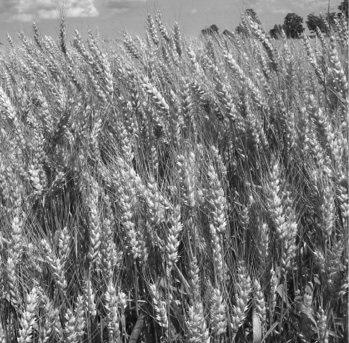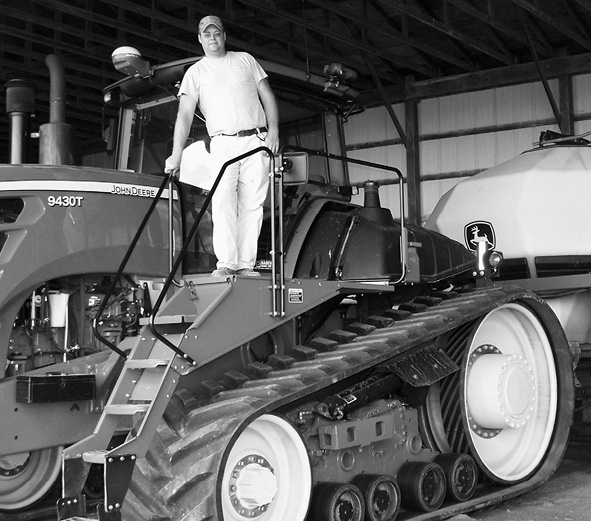Check The Specs...
NAME: John Merchant (farms and operates Merchant Grain, LLC; with father, Al)
LOCATION: Cass City, Mich.
YEARS IN NO-TILLING: 19
ACRES NO-TILLED: 4,600
CROPS NO-TILLED: Soybeans, soft red winter wheat and soft white winter wheat.
When I left home to attend Michigan State University in 1989, Dad was following a conservation-tillage program.
The typical scenario was fall discing, fall ripping and spring field cultivating. We were growing sugarbeets, corn, soybeans and wheat on mostly heavy clay soils.
While I was earning my degree, Dad started the transition to no-till. It was a challenge, but he soon realized no-till was cutting his labor and fuel bills in half.
Yields started improving and our heavy soils responded to the minimal disturbance — which stood to reason, as we had learned long ago that if we tilled in wet conditions, we were lost.
In 1995, my father presented me a chance to farm in partnership. We struck a deal and I began farming full time.
I was impressed with what Dad had done. No-till seemed to be the most efficient way to raise a crop while improving our soil. A range of soils, mostly clays, were responding favorably.
All of our farms are now no-till. Compaction is under control, and we quit deep ripping. As my Dad says, if you don’t pack it down, you don’t have to rip it.
Picking A Paying Rotation
We stopped raising sugarbeets when Dad switched to no-till. It seemed like an appropriate time to review where we wanted to go with a no-till rotation.
We considered what crops we could handle most efficiently with no-till and what combination would make us the most money. Though somewhat unusual in our area, a soybean-wheat sequence came up as the consistent winner.

In 2003, we started a 3-year experiment where we compared yields and costs between no-till corn and soybeans. After penciling it out, we found we made as much or more money on soybeans in two seasons. In one of the three, we made a lot more money from soybeans.
If we spent more time improving our corn-growing skills, would it do better? Probably. But frankly, compared to soybeans and wheat, corn is a pain. Besides requiring a costly planter and corn head, the sheer volume of corn requires an extra truck at harvest time, more drying time and another person to run the dryer.
We also measured a slight yield loss when harvesting soybeans after corn because the header was riding over the tops of the old corn stalks.
So, besides just comparing production costs, there are many other factors affecting our decision. Soybeans and wheat just seem to mesh like two well-positioned gears.
We also have no-tilled edible beans — navies and black — food-grade soybeans and canola. Winter canola does well with no-till; spring varieties were less successful.
We first rotated in soft red winter wheat after 2 years of soybeans. Recently, however, we’ve found that a bean-wheat rotation does very well. This year, we have 2,100 acres of wheat, split between soft red and soft white, and 2,500 acres of Roundup Ready soybeans.
Our 5-year-average no-till wheat yields exceed 90 bushels per acre, topping 100 bushels in a good year. This compares to a county average in the mid-70s.
The 5-year soybean average is 50 bushels per acre and it keeps growing. We had the highest yield ever in 2008 with 58 bushels per acre.
Seven Critical Focus Points
These yields don’t just happen. While wheat is still treated as a low-input crop with limited profit potential on many farms, we follow a strict version of intensive wheat management principles endorsed by seed companies and universities.
Soybeans get the same close scrutiny. Basically it boils down to focusing on every yield-limiting factor from fertility to residue management. We would agree with experts who say intensive management can boost yields by 20% to 40%.
- Variety/Type.
This year, we have about a 50:50 ratio of soft red to soft white. While soft white is more risky to grow (8 to 10 bushels less yield some years), the payback comes from premiums. Millers like the white bran. It cooks up golden brown vs. the dark brown from soft red.
While yield is our top priority when selecting varieties, it pays to search for wheat or soybeans that hold up and yield consistently under severe conditions.
Winter hardiness and disease resistance are also very important. Wheat yield plots will show as much as 15 to 20 bushels difference between varieties depending on seasonal weather fluctuations.
- Disease/Pest Control.
We usually make three fungicide applications on wheat to control a wide range of diseases, including Septoria, a complex of rust pathogens and tan spot.
We mix Headline fungicide with Affinity herbicide in May, with a second Headline application at flag leaf emergence. Proline or Folicur, for control of fusarium head blight (scab), is applied after wheat heads out and starts to flower.
The total fungicide program for wheat runs about $35 per acre, but we’ve seen a yield difference of 20 bushels per acre just from treating fusarium head blight.
We apply Headline on soybeans at the V4 (fourth trifoliate) growth stage.
We scout fields routinely. But since insect pressure usually advances in our area from south to north, we know that if aphids or armyworms are reported in southern counties, we can count on a call from our ag retailer to be ready to treat if they reach economic populations.
- Planting/Fertility.
Like everything else related to the no-till transition, our planting equipment has evolved. Our first no-till soybeans and wheat were planted with a John Deere 750 no-till drill, the mainstay machine in its day.
Then we found a drill that taught us a lot about proper fertilizer placement. We had heard about the Yielder drill, first manufactured and sold in Washington state by the Swanson family.
In 1995, we bought one of the last four Yielders ever built, just before the company switched from making drills to precision application systems. This 20-foot, heavy-duty machine made it possible to plant and simultaneously apply fertilizer with the seed. It could meter five different materials at the same time.
We used the Yielder, with a number of modifications, for about 6 years. The big lesson we learned over the years was if you’re no-tilling wheat, placing phosphate and potash fertilizer in the soil in a band — whether with the seed, or just to the side — is a no-brainer for top yields.
We’ve seen a significant yield advantage to banding fertilizer vs. broadcasting on both wheat and soybeans.
We find some yield advantage to split nitrogen applications. At planting, we apply 100 to 120 pounds of MAP (11-52-0). After planting, a commercial applicator applies potash variable rate (based on grid soil tests) mixed with ammonium sulfate containing 42 pounds of actual nitrogen.
In the spring, we apply 25 gallons of 28%, or about 75 pounds of actual nitrogen. This brings total nitrogen to about 128 pounds per acre.
Today, we use a 42.5-foot John Deere 1890 no-till air seeder with a tow-between 1910 commodity cart (with tanks for seed and fertilizer) for both wheat and soybeans. We have not seen a need for modifications. As seed and fertilizer is metered, it drops into the airstream, where it flows back to the same tube and into the seed furrow together.

We like 7.5-inch rows. This spacing helps spread fertilizer over more area and reduces the chance of seed damage. When we split a field, planting half in 7.5-inch rows and the other half in 30-inch soybeans, we harvested 4.5 more bushels per acre from the narrower rows. We probably would not see that much difference with 15- or 20-inch rows.
- Seeding Dates/Rates.
Wheat planting starts when we finish soybean harvest. We hope to finish planting wheat by Oct. 5, but some years it stretches to Oct. 15.
Delays can be expensive. Yields can drop 10% to 15% when planting Oct. 20 vs. Oct. 15. Ontario researchers say that if you go beyond Oct. 5, it’s better to delay planting until after Nov. 1. We have not tried that, yet.
Most of our soybeans are Late Group 1 to Early Group 2 varieties. We’ve cut soybean seeding rates to about 170,000 compared to 200,000 when we started no-tilling.
The grid soil sampling program we started last year has revealed a need for supplemental manganese on soybeans.
- Weed Control.
Joining Dad full time in 1995 corresponded closely to the shift from pre-emergence to post-emergence herbicides. As applications of herbicides and fungicides increased, it justified the investment in a self-propelled sprayer.
We evolved from a John Deere 4710 to a 4720, and now have a John Deere 4930, with a 1,200-gallon tank and 120-foot boom. We’re on a program to upgrade sprayers every 2 years.
It’s a big investment, but we’re convinced a self-propelled sprayer is a money saver and a moneymaker. When we add up all the costs for labor, machine and fuel, it runs considerably less than hiring a custom applicator, and we can do the spraying when we want it done.
A fall application of Valor herbicide mixed with glyphosate in wheat stubble nails a number of winter annuals. Valor is good on bindweed, chickweed and dandelions, while glyphosate cleans up volunteer wheat and other grasses. This treatment usually leaves the field clean enough to save a spring glyphosate trip.
Some of our toughest weed challenges before no-till, like quackgrass, thistles and milkweed, are almost a non-issue today. We credit that to less soil disturbance and the combined effects of a strong glyphosate program in soybeans, plus post-emergence herbicides like Harmony Extra and Affinity on our wheat acres.
- Compaction Control.
Dad was an early advocate of tracked equipment on our heavy, prone-to-compaction soils. We first equipped our combine with tracks and eventually went to tracked tractors and tracked grain carts.
Distributing the weight on the heaviest machines makes sense. We used to have more compaction issues when we were tilling. Dad calculated that investing in tracks could pay off in only 3 years.
While Deere no longer offers tracks for combines, tire design for compaction control has advanced significantly. We now order our new combines with the widest and lowest pressure tires that are practical to achieve a wider footprint.
Also, to help reduce the soil load, we dump the combine when the hopper is two-thirds full and use a tracked grain cart. Before tracked machines were commercially available, Dad bought combines and grain carts without tires and added his own tracks.
We still believe in tracks, but we have had to strike a balance. It has not been practical — thus far, anyway — to install tracks on the sprayer, although that may change. I need to make $80,000 for a set of sprayer tracks to pencil out. I’ve located a company in Europe that will build them, but for now it’s not economical,
- Harvest/Residue.
Efficient harvest starts for us with a 40-foot MacDon flex draper head. It functions well at higher operating speeds, feeds much more smoothly than an auger head and reduces header crop loss. The header does a great job in either wheat or soybeans, which also adds to the convenience.
After several years of no-tilling, residue becomes an issue. Even though we bale off the straw, there is a layer of chaff behind the combine that keeps the soil surface cool and wet and provides a great environment for slugs. We have experimented with vacuums, blowers and shallow strip tillage to distribute chaff.
GPS Pioneers
My experience with GPS started in 1996, when I bought a lightbar Trimble had adapted from a system designed for airplanes. We progressed through several generations and then to Deere’s AutoTrac system with SF2 repeatability.
We now have it installed in all tractors, the sprayer and combine. Automated steering is an efficiency tool that saves fuel and labor, but it’s more than that.
When you think about the impact of overlapping 2 or 3 feet every pass across 4,600 acres, which can easily happen without GPS guidance, it adds up to a lot of unnecessary chemical load (and cost) and potential environmental harm.
What's New?
To add another dimension to intensive no-till crop management, we installed a center pivot sprinkler this year on a square quarter-section field. We want to experiment with water management and fertigation to see what these elements might add to our yield potential.
We’re hoping to gain 20% to 25% in yield increases. We have penciled out that we need to get 5 more bushels of soybeans and 12 more bushels of wheat to pay off the irrigation investment over 10 years.
If we can get 10 more bushels of soybeans and 20 more bushels of wheat, which will put us over the 100-bushel-per-acre mark, we will be very satisfied. Our 400-foot, 1,200-gallon well will easily handle another quarter-section system.
We’ll look at the potential of double-cropping beans under irrigation.
Moisture for rapid germination is the most limiting factor when you attempt to double-crop soybeans this
far north.








Post a comment
Report Abusive Comment